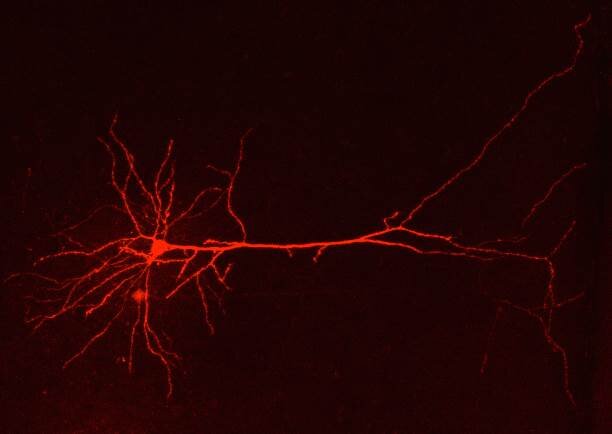

Morphological reconstruction of a neuron of the cingulate cortex in a migraine episode. Credit: UZH
Neuroscientists at the University of Zurich shed new light on the mechanisms responsible for familial migraine: they show that genetic dysfunction in brain cells specific to the area of the cingulate cortex strongly influences the onset of headache pain.
Migraine is one of the most disabling disorders, affecting one in seven people and causing a tremendous social and economic burden. Several findings suggest that migraine is a disease that affects a large part of the central nervous system and is characterized by a global dysfunction in the processing and integration of sensory information, which also occurs between episodes of migraine (interictal period). For example, migraine patients exhibit increased cortical responses to sensory stimuli during the interictal period. Currently, the cellular mechanisms responsible for these alterations are largely unknown.
Malfunction of astrocytes in the cingulate cortex
A team of neuroscientists led by Mirko Santello at the Institute of Pharmacology and Toxicology at the University of Zurich, in collaboration with the University of Padua, has identified a new mechanism involved in a special form of migraine caused by genetic mutation. They report that this type 2 familial hemiplegic migraine (FHM2) causes astrocytes to malfunction in the cingulate cortex, a region of the brain that is involved in pain sensation. Astrocytes, specific star-shaped brain cells, are essential contributors to neuronal function and have a strong impact on brain circuits and behavior.
“Despite their abundance, neuroscientists have relatively overlooked astrocytes,” says Mirko Santello, the study’s latest author. However, these cells are extremely important in eliminating the transmitters released by neurons. In their study, the researchers were able to show that in familial migraine, astrocytes cannot eliminate the excessive transmitters released by neurons. “Impaired uptake of astrocytic glutamate in the cingulate cortex strongly increases cortical dendritic excitability and therefore increases neuron activation,” says Santello.
Less migraine due to genetic manipulations
Furthermore, the study reported that malfunctioning of the cingulate cortex also influences the occurrence of migraine. In a mouse model, the researchers showed that the mice showed increased sensitivity to headache triggers. “By manipulating astrocytes in the cingulate cortex, we were able to reverse their dysfunction. This prevented an increase in headache in mice carrying the genetic defect,” says Jennifer Romanos, first author of the study.
Migraine is a complicated disorder that affects part of the nervous system. “Our results provide a clear example of how astrocyte dysfunction caused by a genetic defect affects neuronal activity and sensitivity to headache triggers,” explains Mirko Santello. The findings help to better understand the pathophysiology of migraine and suggest that the cingulate cortex may represent a critical center in the disease. Demonstrating the link between astrocyte dysfunction in the cingulate cortex and familial migraine could help design new treatment strategies for migraine.
Migraine sufferers’ brains are hyperexcitable, new study suggests
Jennifer Romanos et al. Astrocyte dysfunction increases cortical dendritic excitability and promotes head pain in familial migraine. Scientific advances (2020). DOI: 10.1126 / sciadv.aaz1584
Provided by the University of Zurich
Citation: Genetic malfunction of brain astrocytes triggers migraine (2020, June 24) retrieved June 24, 2020 from https://medicalxpress.com/news/2020-06-genetic-malfunction-brain-astrocytes-triggers .html
This document is subject to copyright. Other than fair dealing for private research or study purposes, no part may be reproduced without written permission. The content is provided for informational purposes only.